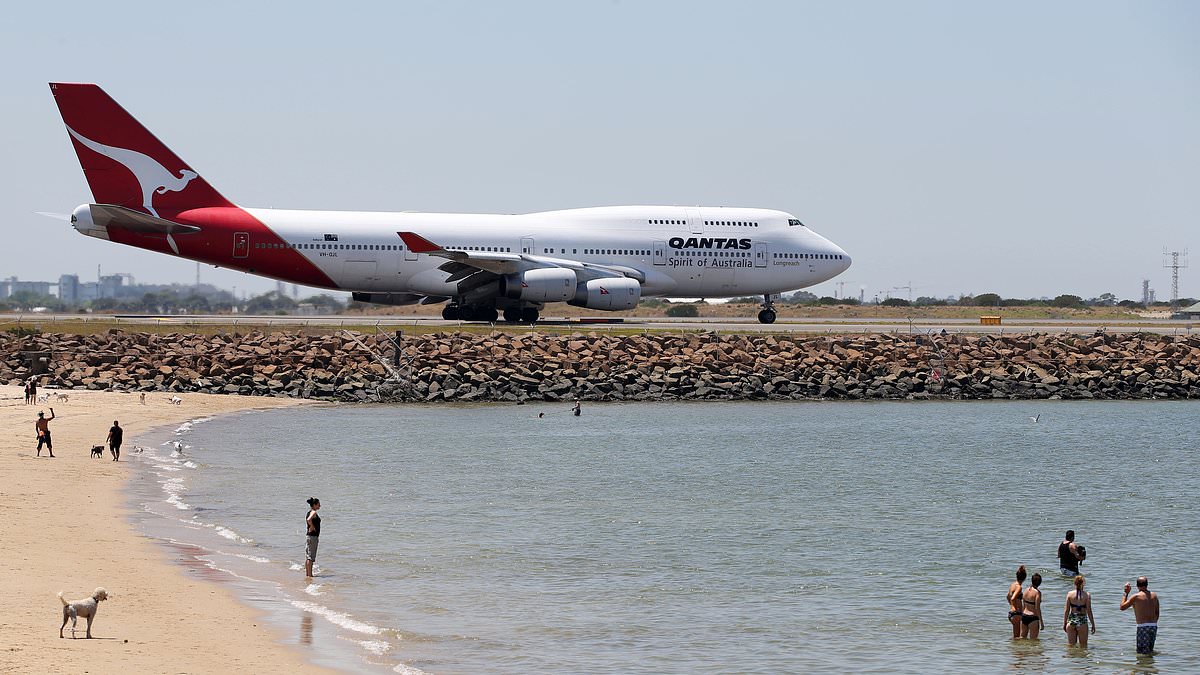A popular Sydney beach has been quietly closed to swimmers over fears the water contains ‘forever chemicals’ that can cause cancer.
Tower Beach, or ‘Plainspotting Beach,’ beside Sydney Airport, has had ‘no swimming’ and ‘no fishing’ signs installed without any fanfare, though unsuspecting residents continue to get in the water as temperatures soar.
An underground body of water, known as the Botany Sands Aquifer, beneath the airport is contaminated with dangerous levels of per- and polyfluoroalkyl substances (PFAS).
PFAS have been linked to cancer and are deemed ‘forever chemicals’ because they never break down in the environment.
The ‘no swimming’ signs were quietly installed two years ago, but swimmers, fishermen and horse riders continue to frequent the beach.
Families with young children favour the beach because of its calm waters.
Tower Beach is also popular among aircraft enthusiasts who enjoy the view of the airport’s main runway.
A local resident, Terry Daly, was left outraged by Sydney Airport’s lack of transparency about the threat and the poor visibility of the ‘no swimming’ signs.
‘Tiny kids are playing on the sand there all the time,’ Mr Daly told the Sydney Morning Herald.
The presence of PFAS across NSW, including at Botany Bay, is subject to an ongoing investigation by the NSW EPA.
A spokeswoman for the environmental watchdog said this week it was continuing to urge the federal Department of Infrastructure, Transport and Regional Development, which regulates the airport land, to protect Aussies from PFAS.
‘Transparency around the level of contamination is important to ensure community awareness,’ the spokeswoman said.
But there’s a stoush over who should pay for the clean-up: Sydney Airport or Airservices which used PFAS-containing foams in its fire fighting operations at the airport up until 2010.
Airservices is conducting its own investigation into the presence of PFAS at the airport, with the result expected in mid-2025.
It comes after low levels of PFAS were also detected in Sydney’s drinking water catchments in June 2024.
Testing revealed the carcinogens were present in major filtration plants, including Orchard Hills, Prospect Reservoir and Warragamba.
However, there were no detectable levels of PFAS in catchments in Macarthur, Nepean, the Woronora River or the Illawarra.
The concentration levels are within ‘s drinking water safety limits but are far higher than what US authorities deem safe to drink.
The results of the tests conducted by Sydney Water prompted the country’s largest water utility to start conducting monthly tests in ‘potentially impacted areas’.
The move contradicted Sydney Water’s previous position that there were no PFAS hotspots in the city’s drinking water catchments.
Per-and poly-fluoroalkyl substances – commonly known as PFAS – are a group of over 14,000 human-made chemicals that have been popular since the 1950s for their diverse uses in resisting heat, water, grease and stains.
They’ve been commonly found in household products like non-stick frying pans, clothing, cosmetics, insecticides, and food packaging, as well as specialty industry products, like firefighting foam.
But despite their broad skillset, the chemicals have a dark side: they’re known as ‘forever chemicals’ because once they’re in the environment – or our bodies – they don’t degrade further.
PFAS have been linked to environmental and health issues, including some cancers, but a lot remains unknown about the true scale and potential impacts of the problem – including how much is in our water supply.
